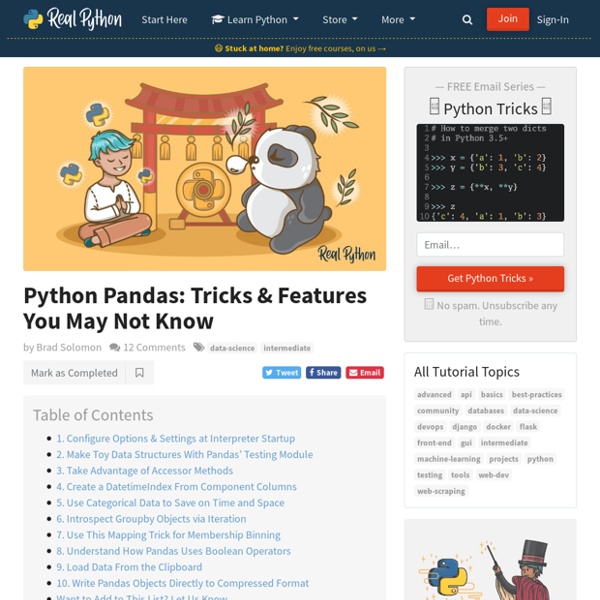Python Pandas: Tricks & Features You May Not Know

https://realpython.com/python-pandas-tricks/
Related: Python
• Python Stack
• pandas
Logging Cookbook — Python 3.4.0 documentation
This page contains a number of recipes related to logging, which have been found useful in the past. Using logging in multiple modules Multiple calls to logging.getLogger('someLogger') return a reference to the same logger object. This is true not only within the same module, but also across modules as long as it is in the same Python interpreter process. It is true for references to the same object; additionally, application code can define and configure a parent logger in one module and create (but not configure) a child logger in a separate module, and all logger calls to the child will pass up to the parent.
Pandas Tricks - Combine Data In Different Ways
Introduction If you have used pandas for your data analysis work, you may already get some idea on how powerful and flexible it is in terms of data processing. Many times there are more than one way to solve your problem, and choosing the best approach become another tough decision. For instance, in one of my previous article, I tried to summarize the 20 ways to filter records in pandas which definitely is not a complete list for all the possible solutions. In this article, I will be discussing about the different ways to merge/combine data in pandas and when you shall use them since combining data probably is one of the necessary step you shall perform before starting your data analysis. Prerequisites
Pyreverse : UML Diagrams for Python (Logilab.org)
Pyreverse analyses Python code and extracts UML class diagrams and package depenndencies. Since september 2008 it has been integrated with Pylint (0.15). Introduction Pyreverse builds a diagram representation of the source code with:
Merge, join, concatenate and compare — pandas 1.2.4 documentation
pandas provides various facilities for easily combining together Series or DataFrame with various kinds of set logic for the indexes and relational algebra functionality in the case of join / merge-type operations. In addition, pandas also provides utilities to compare two Series or DataFrame and summarize their differences. Concatenating objects
The 8 Best Free Python Cheat Sheets for Beginners and Experts in 2019
Last Updated on July 31, 2019 Python Cheat Sheet can be really helpful when you’re working on a project or trying a set of exercises related to a specific topic. If you are just getting started with Data Science or Machine Learning, i’ve got you covered in this blog post about Learning how to learn Data Science (Python, Maths and Statistics). And now rather than explaining to you the importance of cheat sheets, why not just begin with the most useful Python resources available on the internet (for free) in the form of cheat sheet. Here’s a curated a list of Python Cheat Sheets and most commonly used Python Libraries.
40 Examples to Master Pandas. A comprehensive practical guide
Pandas is one of the most widely-used data analysis and manipulation libraries. It provides numerous functions and methods to clean, process, manipulate, and analyze data. The best way to get comfortable working with Pandas is through practice. I previously wrote a practical guide that contains 30 examples. In this article, I will enrich the examples to cover a broader scope together with the previous article. 40 examples in this article will include not only the basic functions and techniques but also some extreme cases.
Python Crash Course by ehmatthes
These are the resources for the first edition; the updated resources for the second edition are here. I'd love to know what you think about Python Crash Course. Please consider taking a brief survey.
Pandas Pivot Table Explained - Practical Business Python
Introduction Most people likely have experience with pivot tables in Excel. Pandas provides a similar function called (appropriately enough) pivot_table . While it is exceedingly useful, I frequently find myself struggling to remember how to use the syntax to format the output for my needs.
Usage — RISE 5.5.1
You can see in this youtube video a very short session on how to use RISE to create and run a slideshow. Let us emphasize the key points here. Creating a slideshow
A Comprehensive Guide to Pandas for Data Science
Standard IndexingUsing iloc → Position based IndexingUsing loc → Label based Indexing Standard Indexing Selecting rows
What is Metaflow - Metaflow
Metaflow is a human-friendly Python library that helps scientists and engineers build and manage real-life data science projects. Metaflow was originally developed at Netflix to boost productivity of data scientists who work on a wide variety of projects from classical statistics to state-of-the-art deep learning. Metaflow provides a unified API to the infrastructure stack that is required to execute data science projects, from prototype to production. Models are only a small part of an end-to-end data science project. Production-grade projects rely on a thick stack of infrastructure.
Related:



